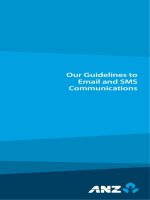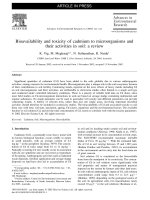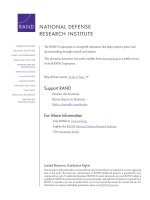How Is Deployment to Iraq and Afghanistan Affecting U.S. Service Members and Their Families potx
Bạn đang xem bản rút gọn của tài liệu. Xem và tải ngay bản đầy đủ của tài liệu tại đây (440.42 KB, 62 trang )
For More Information
Visit RAND at www.rand.org
Explore the RAND National Defense Research Institute
View document details
Support RAND
Purchase this document
Browse Reports & Bookstore
Make a charitable contribution
Limited Electronic Distribution Rights
is document and trademark(s) contained herein are protected by law as indicated in a notice appearing
later in this work. is electronic representation of RAND intellectual property is provided for non-
commercial use only. Unauthorized posting of RAND electronic documents to a non-RAND website is
prohibited. RAND electronic documents are protected under copyright law. Permission is required from
RAND to reproduce, or reuse in another form, any of our research documents for commercial use. For
information on reprint and linking permissions, please see RAND Permissions.
Skip all front matter: Jump to Page 16
e RAND Corporation is a nonprot institution that helps improve policy and
decisionmaking through research and analysis.
is electronic document was made available from www.rand.org as a public service
of the RAND Corporation.
CHILDREN AND FAMILIES
EDUCATION AND THE ARTS
ENERGY AND ENVIRONMENT
HEALTH AND HEALTH CARE
INFRASTRUCTURE AND
TRANSPORTATION
INTERNATIONAL AFFAIRS
LAW AND BUSINESS
NATIONAL SECURITY
POPULATION AND AGING
PUBLIC SAFETY
SCIENCE AND TECHNOLOGY
TERRORISM AND
HOMELAND SECURITY
This product is part of the RAND Corporation occasional paper series. RAND occa-
sional papers may include an informed perspective on a timely policy issue, a discussion
of new research methodologies, essays, a paper presented at a conference, a conference
summary, or a summary of work in progress. All RAND occasional papers undergo
rigorous peer review to ensure that they meet high standards for research quality and
objectivity.
OCCASIONAL PAPER
How Is Deployment to Iraq and
Afghanistan Affecting U.S. Service
Members and Their Families?
An Overview of Early RAND Research
on the Topic
James Hosek, Editor
Prepared for the Office of the Secretary of Defense
Approved for public release; distribution unlimited
NATIONAL DEFENSE RESEARCH INSTITUTE
The RAND Corporation is a nonprofit institution that helps improve policy and
decisionmaking through research and analysis. RAND’s publications do not necessarily
reflect the opinions of its research clients and sponsors.
R
®
is a registered trademark.
© Copyright 2011 RAND Corporation
Permission is given to duplicate this document for personal use only, as long as it
is unaltered and complete. Copies may not be duplicated for commercial purposes.
Unauthorized posting of RAND documents to a non-RAND website is prohibited. RAND
documents are protected under copyright law. For information on reprint and linking
permissions, please visit the RAND permissions page (
permissions.html).
Published 2011 by the RAND Corporation
1776 Main Street, P.O. Box 2138, Santa Monica, CA 90407-2138
1200 South Hayes Street, Arlington, VA 22202-5050
4570 Fifth Avenue, Suite 600, Pittsburgh, PA 15213-2665
RAND URL:
To order RAND documents or to obtain additional information, contact
Distribution Services: Telephone: (310) 451-7002;
Fax: (310) 451-6915; Email:
Cover photo by Staff Sgt. Ryan C. Matson, courtesy of the United States Army
The research reported here was sponsored by the Office of the Secretary of Defense (OSD).
The research was conducted jointly by the Center for Military Health Policy Research, a
RAND Health program, and the Forces and Resources Policy Center, a RAND National
Defense Research Institute (NDRI) program. NDRI is a federally funded research and
development center sponsored by OSD, the Joint Staff, the Unified Combatant Commands,
the Navy, the Marine Corps, the defense agencies, and the defense Intelligence Community
under Contract W74V8H-06-C-0002.
Library of Congress Cataloging-in-Publication Data
Hosek, James R.
How is deployment to Iraq and Afghanistan affecting U.S. service members and their families? : an overview of
early RAND research on the topic / James Hosek.
p. cm.
Includes bibliographical references.
ISBN 978-0-8330-5201-8 (pbk. : alk. paper)
1. Psychology, Military. 2. Iraq War, 2003 Psychological aspects. 3. Afghan War, 2001 Psychological aspects.
4. Deployment (Strategy) —Psychological aspects. 5. Soldiers–Mental health—United States. 6. United States—
Armed Forces—Personnel management. 7. United States—Armed Forces—Recruiting, enlistment, etc.
8. Families of military personnel—Services for—United States. I. Title.
U22.3.H67 2011
956.7044'34—dc22
2011005158
iii
Preface
e extended wars in Iraq and Afghanistan over the past decade have aected the lives of
approximately two million U.S. service members and their families in many dierent ways.
In an all-volunteer force, the nature of those eects warrants proper attention, because the
well-being of troops and the people close to them is a central concern. On one side, it aects
military readiness and the ability of the U.S. armed forces to carry out their mission. On the
other, it is something the nation has committed itself to in appreciation of the sacrices made
by military families.
Eective policies to facilitate the well-being of this community require a comprehen-
sive understanding of the myriad issues and consequences that service members and their
families may face due to the stress of deployment. Yet for much of the 2000s, such understand-
ing was largely lacking. Recognizing the need for analysis, around 2005, the RAND Corpo-
ration launched a program of research designed to investigate this theme and, where possible,
oer policymakers informed recommendations. is occasional paper introduces this body of
work—ongoing today—by presenting an overview of six of the earliest RAND studies on vari-
ous aspects of the theme. It calls attention to the pressing policy questions, summarizes the key
ndings and policy implications, and, where applicable, lays out recommendations.
e research described in this paper will be of interest to policymakers, analysts, sta
of the U.S. Department of Defense, members of the military community, the service provid-
ers who work with and for them, and readers generally concerned with how current military
operations are aecting U.S. troops and their families.
e six studies summarized here were conducted within two centers at RAND. e rst
is the Forces and Resources Policy Center of the RAND National Defense Research Institute.
is is a federally funded research and development center sponsored by the Oce of the Sec-
retary of Defense, the Joint Sta, the Unied Combatant Commands, the Navy, the Marine
Corps, the defense agencies, and the defense Intelligence Community. e second is RAND
Health’s Center for Military Health Policy Research. is center taps RAND expertise in both
defense and health policy to conduct research for the Department of Defense, the Veterans
Administration, and nonprot organizations. RAND Health aims to transform the well-being
of all people by solving complex problems in health and health care.
For more information on the Forces and Resources Policy Center, see d.
org/nsrd/about/frp.html or contact the director (contact information is provided on the web
page). For more information on the Center for Military Health Policy Research, see http://
www.rand.org/multi/military.html or contact the co-directors (contact information is pro-
vided on the web page).
v
Contents
Preface . iii
Figures
. vii
Acknowledgments
. ix
1. Introduction
. 1
2. How Has Deployment Aected Reenlistment?
3
How Has Deployment Aected Work Stress, Personal Stress, and the Intention to Stay
in the Military?
. 4
A Detailed Look at the Eect of Deployment on Reenlistment
. 6
Counteracting the Negative Eect of Cumulative Deployment on Army Reenlistment
in 2006 and 2007
. 9
3. e Consequences of Combat Stress in Iraq and Afghanistan: Eects on Troop
Performance
. 13
Performance May Suer When Individuals Are Under Stress
. 14
Is Stress Always Bad? Finding the Right Balance Between Too Much and Too Little
. 15
e Military Can Use Training and Other Moderators to Reduce the Negative Eects of
Stress
. 16
Training Programs Should Follow Several Core Guidelines
. 17
4. e Invisible Wounds of War: Psychological and Cognitive Injuries Among Veterans
of Iraq and Afghanistan
. 19
Understanding Invisible Wounds: e Research Challenge
. 20
About One-ird of Returning Service Members Reported Symptoms of a Mental Health
or Cognitive Condition
. 20
Many Services Are Available, But the Care Systems Have Gaps
. 21
Access Gaps
. 22
Quality Gaps
. 22
Improving Access to High-Quality Care Can Save Money and Improve Outcomes
. 23
Recommendations and Conclusions
. 25
5. Called to Duty: e Eects of Deployment on the Earnings of Reservists and How
eir Families Coped During the Reservists’ Absence
. 27
Have Deployments Caused Reservists to Lose Income?
. 29
Overall, the Earnings of Reservists Increase During Deployment
. 29
Unactivated Reservists Are Even More Likely to Experience an Earnings Loss
. 30
e Net Increase in Reservists’ Earnings Grows Substantially Larger with the Number
of Days Deployed
. 31
vi How Is Deployment to Iraq and Afghanistan Affecting U.S. Service Members and Their Families?
Why Do the RAND Estimates Dier So Considerably from the Estimates Based on
Survey Data?
. 31
How Are Members of the Reserve Component and eir Families Coping with the New
Pace of Deployment?
. 32
What Issues Did Reserve Component Families Face?
. 33
What Resources Did Reserve Component Families Use During Deployment?
. 37
What Were Reserve Component Families’ Plans for Reenlistment?
. 37
Constructive Steps in Several Areas Can Improve the Experience of Reserve Component
Families During Deployment
. 39
6. A Military of Families: How Deployment of a Service-Member Parent Aects
Children on the Homefront
. 41
Children of Deployed Parents Experience Behavioral and Emotional Diculties at Rates
Above National Averages
. 42
Four Factors Put Certain Groups More at Risk
. 43
Older Teens Experienced More Diculties
. 43
Girls Reported More Diculties During Reintegration
. 43
Longer Total Months of Parental Deployment Were Associated with More Problems
for Children
. 44
Children Whose Non-Deployed Parent Reported Better Emotional Health Had Fewer
Diculties
. 44
Several Limitations to the “Operation Purple Camp” Study Should Be Kept in Mind
. 44
Interventions Are Needed to Help the Children of Deployed Parents Cope with ese
Diculties
. 45
7. A Few Words in Conclusion
. 47
References
. 49
vii
Figures
2.1. Number of U.S. Service Members Deployed, 1996–2007 3
2.2. Eect of Deployment on Work and Personal Stress, First Term, by Service
. 5
2.3. Eect of Deployment on the Intention to Reenlist, First Term, by Service
. 5
2.4. Eect of Deployment on Army Reenlistment for Hostile Deployment in 12 Months
Prior to Reenlistment Decision, by Year
. 7
2.5. Eect of Soldiers’ Cumulative Months of Hostile Deployment on Reenlistment,
1996 –2007
. 9
2.6. Cumulative Months of Hostile Deployment in the Army, 1996–2007
. 10
2.7. First-Term Reenlistment by Service, 1996–2007
. 10
2.8. Percentage of Reenlisting First-Term Soldiers Receiving Bonuses and Bonus
Amounts, 1996–2007
. 11
3.1. Traumatic Events Experienced by Troops in Afghanistan and Iraq
. 14
3.2. Progression from Stressors to Negative Eects on Performance
. 15
3.3. Relationship Between Stress and the Quality of Performance
. 15
3.4. Two Categories of Moderators at Lessen the Negative Eects of Stress on
Performance
. 16
4.1. An Estimated 19 Percent of Troops at Had Returned from Iraq and Afghanistan
Had a Mental Health Condition
. 21
4.2. Top Five Barriers to Seeking Mental Health Care
. 22
4.3. Costs per Case—Including Medical Costs, Productivity Costs, and Costs of Lives
Lost to Suicide—at Would Be Saved by Investing More in Evidence-Based Care
. 24
5.1. Activations of Reservists, Fiscal Years 1986–2004
. 28
5.2. Average Change in Annual Civilian and Military Earnings for Deployed Reservists,
2002–2003
. 30
5.3. Net Change in Annual Earnings in 2002–2003, by Number of Active-Duty Days
. 31
5.4. e ree Top Denitions of Readiness, by Service Members and Spouses
. 34
5.5. How Well Reserve Component Families Coped with the Most Recent Deployment
. 35
5.6. Problems Related to Deployment, by Service Members and Spouses
. 36
5.7. Positive Aspects of Deployments, by Service Members and Spouses
. 37
5.8. Intention to Reenlist in the Military, by Service Members and Spouses
. 38
5.9. Eect of Deployment Experiences on Service Members’ Intentions to Reenlist in the
Military
. 38
5.10. Service Members’ Impressions of How eir Spouses Felt About eir Staying in the
Military vs. Surveyed Spouses’ Opinions
. 39
6.1. Behavioral and Emotional Diculties Among Military Children vs. Children in the
General U.S. Population, Ages 11–14 and 15–17
. 42
6.2. Proportion of Elevated vs. Low Symptoms of Anxiety in Study Sample and Other
Child Studies
. 43
ix
Acknowledgments
e authors of the documents summarized in this paper sincerely wish to thank RAND col-
league Susan Bohandy for her role in preparing the summaries.
1
1. Introduction
e conicts in Iraq and Afghanistan have put the all-volunteer force to its most severe test
since its inception in 1973. Of all of the wars the United States has fought to date, Afghanistan
is the second longest, with Iraq taking a close third place—both superseded only by Vietnam.
In this environment of ongoing demand for battle-ready soldiers, sailors, airmen, and marines,
concerns are growing about the eects and consequences of prolonged stress on the force as a
whole, and on individual service members and their families. Among the concerns are ques-
tions about the resilience of the all-volunteer force, potential earnings losses of activated reserv-
ists, the nature of battleeld casualties, the care service members receive if wounded, and the
emotional health of the children of deployed parents.
Over the past ve years, the RAND Corporation has produced a diverse body of research
that oers insight into these issues. ese studies were among the rst to take up the theme
of how deployments to Iraq and Afghanistan are aecting service members and their families,
and to oer policymakers informed recommendations. e earliest study, reported in Stress
and Performance, was completed in 2005 (Kavanagh, 2005). It took a detailed look at how the
acute stress of today’s military deployments might alter the performance of service members in
the theater. Activation and the Earnings of Reservists (Loughran, Klerman, and Martin, 2006)
followed in 2006, describing an investigation of whether deployment led to a loss of income for
reservists while away from their civilian jobs. e year 2008 saw the publication of two reports:
Invisible Wounds of War (Tanielian and Jaycox, 2008), based on a comprehensive study of the
psychological and cognitive injuries of deployed service members, and Deployment Experiences
of Guard and Reserve Families (Castaneda et al., 2008), based on a study that probed the unique
experience of families of activated guardsmen and reservists. In 2009, RAND released How
Have Deployments During the War on Terrorism Aected Reenlistment? (Hosek and Martorell,
2009). is study, which included an analysis of actual reenlistment behavior and expanded on
an earlier study based on focus groups and data on intentions (How Deployments Aect Service
Members, Hosek, Kavanagh, and Miller, 2006), examined whether current deployments were
negatively aecting reenlistment rates within the four services. “Children on the Homefront:
e Experience of Children from Military Families,” published as a journal article in early
2010 (Chandra et al., 2010), reported on a study of the issues faced by children of a deployed
parent while that parent is absent and after he or she returns.
ese six studies sparked the development of a rich body of research that continues to
grow. Some of the study results and recommendations are no longer new, but they have none-
theless laid important groundwork and set the direction for newer studies being carried out
today. is paper brings the research together in an abridged form, highlighting the policy
questions, key ndings, and policy implications.
3
2. How Has Deployment Affected Reenlistment?
Hosek and Martorell, 2009:
How Have Deployments During the War
on Terrorism Affected Reenlistment?
More than 1.7 million U.S. service members have been deployed since 2002 for Operation Iraqi
Freedom (OIF) in Iraq and Operation Enduring Freedom (OEF) in Afghanistan. During the
invasion of Iraq in 2003, the number of troops in the two theaters jumped to nearly 300,000,
and the monthly count of service members deployed since then for hostile duty—including
those in other theaters—has ranged from 150,000 to 200,000 (Figure 2.1). e operations
have been manned on a rotational basis. is approach spreads deployments over the entire
pool of deployable service members. But because the Iraq and Afghanistan operations have
been so lengthy, there have been multiple deployments for many personnel, especially soldiers
and marines. Army and Marine units, and unit members, have also deployed more frequently
Figure 2.1
Number of U.S. Service Members Deployed, 1996–2007
0
50,000
100,000
150,000
200,000
250,000
300,000
Army
Marine Corps
Navy
Air Force
Number of personnel
RAND OP316-2.1
1996 1998 2000 2002 2004 20061997 1999 2001 2003 2005 2007
4 How Is Deployment to Iraq and Afghanistan Affecting U.S. Service Members and Their Families?
than planned, and have had less time between deployments to recuperate, regenerate, and
train and exercise for the next deployment. In addition, most personnel have been exposed to
combat or imminent danger while deployed. Long hours, poor living conditions in the theater,
and limited communications with families compound these stresses.
A key question has been whether the demanding tempo of deployments has caused reen-
listment rates to decrease. A drop in rst- and second-term reenlistment rates would mean the
loss of trained, experienced personnel and greater turbulence in unit manning. At the same
time, to oset the higher outow of personnel, an increase in recruitment and training would
be needed.
is study focused on a period starting in 1996, before the conicts in Afghanistan and
Iraq erupted, and ending in 2007. e RAND study team used econometric modeling to esti-
mate how deployment to a hostile environment aected service members’ decision to reenlist.
Deployment is one of many factors inuencing the reenlistment decision, and the models in
the analysis control for the eects of other factors.
1
e study used two data sets, each with dierent information on service members. e
rst contained survey data from ten “Status of Forces Surveys of Active Duty Personnel” con-
ducted between 2002 and 2005. ese surveys asked active-duty personnel about such issues
as work-related and personal stress, intention to stay in the military, number of days worked
that were longer than the usual duty day, whether deployment was longer or shorter than
expected, and individual preparedness for the missions to be undertaken. e second data set
comprised administrative les on pay and personnel that spanned the 11 years from 1996 to
20 07.
RAND received permission to link these two data sets. is oered the advantage of
showing whether intentions to stay in the military were borne out by subsequent reenlistment
decisions. However, the administrative data—which covered all active-duty enlisted person-
nel and included all reenlist/leave decisions for the 1996–2007 period—aorded the most-
detailed insights into the relationship between deployment and reenlistment.
How Has Deployment Affected Work Stress, Personal Stress, and the
Intention to Stay in the Military?
In the Status of Forces surveys, respondents were asked whether their levels of work-related and
personal stress were higher or lower than usual. e study’s analysis estimated whether an indi-
vidual’s reported stress levels, as well as his or her intention to stay in the military, were aected
by having been deployed within the 12 months prior to taking the survey. Soldiers, sailors,
and marines who had been deployed were more likely to report higher-than-usual work stress
and higher-than-usual personal stress. e sizes of these eects were quite similar at rst- and
second-term reenlistments; Figure 2.2 shows the results at rst term. Deployment had a par-
ticularly strong eect on work-related stress among soldiers. In contrast, the eects on airmen
were near zero—that is, deployment did not elevate self-reported stress for deployed airmen
relative to the levels for airmen who did not deploy.
1
Branch of service, occupational specialty, marital status, race/ethnicity, gender, education, Armed Forces Qualication
Test (AFQT) score, years of service, term of service, nature of deployments (i.e., hostile or non-hostile), fast promotion, and
reenlistment bonus may also play a role.
How Has Deployment Affected Reenlistment? 5
Figure 2.2
Effect of Deployment on Work and Personal Stress, First Term, by Service
–.15
–.10
–.05
0
.05
.10
.15
Army Navy Marine Corps Air Force
Deployment effect
Work stress
Personal stress
First term, by service (2002–2005)
RAND OP316-2.2
At the same time, deployment decreased the intention to reenlist at rst term in all ser-
vices, with the eect being strongest among soldiers and marines (Figure 2.3). At second term,
deployment’s eect on the intention to reenlist was negative and smaller in size (closer to zero)
for the Army and Air Force, and zero for the Navy and Marine Corps. is dierence in
deployment eects between rst- and second-term is consistent with ndings in past research
Figure 2.3
Effect of Deployment on the Intention to Reenlist, First Term, by Service
–.15
–.10
–.05
0
.05
.10
.15
Army Navy Marine Corps Air Force
Deployment effect
Work stress
Personal stress
Intention to reenlist
First term, by service (2002–2005)
RAND OP316-2.3
6 How Is Deployment to Iraq and Afghanistan Affecting U.S. Service Members and Their Families?
and probably results from the selective nature of reenlistment: ose with more tolerance for
deployment are more likely to remain in the military at the rst-term reenlistment decision
point, other things being equal.
By linking the survey data to administrative data, the RAND analysts could determine
whether service members followed through on their intentions. ere was a strong tendency to
do so at rst term: ose personnel who as a consequence of deployment said they were “less
likely” or “much less likely” to reenlist, in fact, had a lower probability of reenlisting. But the
eects of deployment on actual reenlistment were considerably smaller than the eects on the
intention to reenlist (half the size or less).
At the second term, though, intentions were not consistent with behavior. e eects of
deployment on actual reenlistment at that time were zero in the Army and Air Force, even
though deployment had a negative eect on the intentions of soldiers and airmen. In the Navy
and Marine Corps, the eects of deployment on actual reenlistment were positive, but zero
when it came to intentions to reenlist. e clear implication of the rst- and second-term nd-
ings was that the eect of deployment on intentions to reenlist, stated at the time of the survey,
underestimated the eect of deployment on subsequent actual reenlistment.
e Status of Forces survey provided other insights on how service members react to
aspects of deployment. ere were several key ndings:
• e survey data included the number of days respondents had served in the previous year
that were longer than the usual duty day. e inclusion of this variable in the analysis
typically shifted toward zero the eect that deployment had on each of the dependent
variables (higher-than-usual work stress, higher-than-usual personal stress, intention to
stay, and actual reenlistment). e implication is that much of what underlies the eect
of “deployment” has to do with the number of long workdays. is is not to discount
the possible role of specic dangers such as improvised explosive devices (IEDs), snipers,
ambushes, and other hazards. But available data sets do not contain variables on these
factors.
• Deployments that were either much shorter or much longer than expected decreased the
intention to stay in the military. is nding implies that service members feel discontent
when reality turns out to be much dierent than expected and suggests the importance of
setting accurate expectations about the length of a deployment. is is consistent with the
view that service members prefer accurate, certain expectations to inaccurate or uncertain
ones: ey prefer to know when the deployment will occur and how long it will be, and
to feel assured that expectations will be met.
• e intention to stay in the military depended on the level of preparedness for the duties
performed while deployed. Service members who felt well prepared were more likely to
state a positive intention to reenlist.
A Detailed Look at the Effect of Deployment on Reenlistment
e four services fared dierently with respect to how deployment aected their personnel.
Making use of the extensive administrative data, the RAND researchers rst explored models
with an indicator for whether the service member had been deployed in the year prior to the
reenlistment decision. e eect of this deployment variable was allowed to vary by year, and
How Has Deployment Affected Reenlistment? 7
separate models were estimated for rst- and second-term personnel by branch of service. e
advantage of this approach was that it could detect possible time trends in the eect of deploy-
ment. For deployment involving hostile duty or imminent danger, the most dramatic trends
were in the Army (Figure 2.4). For both rst- and second-term Army reenlistment, the eect
of deployment was initially positive in 1996 and had a slight downward trend till 2004. e
eect then plummeted from a positive value in 2004 to a negative value in 2006. Analysis of
subgroups added nuance to these ndings but repeated the same pattern:
• e eects of deployment were similar for men and women soldiers during the rst years
of OIF and OEF (and before). But the negative eect in 2006–2007 was stronger for
men. is was true at both rst- and second-term reenlistment.
• In any year during the two operations, the eect of deployment on reenlistment was
less positive or more negative for soldiers in combat arms occupational specialties than
for those not in combat arms specialties. In 2006, the eect in non-combat arms was
to reduce rst-term reenlistment by 7 percentage points (relative to soldiers who had no
hostile deployment), while the eect in combat arms was to reduce reenlistment by 14
percentage points. e 2006 eects at second-term reenlistment were practically identi-
cal. ese ndings represent large impacts on reenlistment rates that were, on average,
about 35 percent at rst term and about 60 percent at second term. e more-pronounced
negative eects among soldiers in combat arms seem likely to be associated with greater
exposure to combat-related traumatic events.
Figure 2.4
Effect of Deployment on Army Reenlistment for Hostile Deployment in 12 Months Prior to
Reenlistment Decision, by Year
–.10
–.05
0
.05
.10
.15
.20
1996 1998 2000 2002 2004 20061997 1999 2001 2003 2005 2007
Effect on reenlistment
Second term
First term
RAND OP316-2.4
8 How Is Deployment to Iraq and Afghanistan Affecting U.S. Service Members and Their Families?
• Deployment eects diered little with respect to marital status at rst term. But at second
term, the deployment eects were 2 to 3 percentage points lower for single personnel than
for married, and this held true throughout the 1996–2007 period.
is raised an important question: Why had the Army experienced this sharp reversal in
deployment’s eect on reenlistment when the other services had not? e results for the Navy,
Marine Corps, and Air Force showed that the eect of deployment on rst-term reenlistment
was small—with near-zero values from 1996 to 2007—and that the eect on second-term
reenlistment was about zero in 2003 and tended to increase from 2003 to 2007, years of heavy
involvement in Iraq and Afghanistan.
2
e cause of this particular trend in the Army appears to be a combination of two factors.
First, the eect of deployment varied with the cumulative months of deployment in the three
years before the reenlistment decision. Second, as a result of the rapid pace and high level of
Army deployments, many soldiers had a large number of cumulative months of deployment.
Cumulative deployment was coded into variables reecting one to six months, seven to 11
months, 12 to 17 months, and 18 or more months, with zero months being the base group. e
eect of one to six months of deployment was positive and increasing after 2002, the eect of
seven to 11 months was near zero, the eect of 12 to 17 months was negative and decreasing
after 2002, and the eect of 18 or more months was still lower and tending to decrease after
2002 (Figure 2.5). In short, the eect of deployment for soldiers with 12 or more months of
deployment was negative.
e Marine Corps results were not as clear-cut as the Army’s, but from 2004 onward,
the eects of seven or more months of deployment (i.e., seven to 11, 12 to 17, and 18 or more
months) were all negative with two exceptions: 12 to 17 months in 2006 and 2007. To put the
Army and Marine Corps results in context, note that Army deployments to OIF/OEF were 12
to 15 months, whereas Marine Corps deployments were typically seven months. us, high
months of deployment also had a negative eect on reenlistment in the Marine Corps.
In 2006, 79 percent of the soldiers at rst-term reenlistment had had some hostile deploy-
ment; and of those deployed, two-thirds had 12 or more cumulative months, and nearly 20
percent had 18 or more cumulative months (Figure 2.6). e Marine Corps had 80 percent of
marines with some deployment, 44 percent of whom had 12 or more months, and 6 percent
of whom had 18 or more months. Cumulative months of deployment were much lower within
the other services. e Navy had 68 percent with some deployment, 3 percent of whom had
12 or more months, and the numbers for the Air Force were 48 percent, 11 percent of whom
had 12 or more months.
Putting the ndings together led to the conclusion that the sharp fall from positive to
negative in deployment’s eect on Army reenlistment from 2004 to 2006 most likely was the
product of the negative eect on reenlistment for soldiers with high numbers of months of
deployment and the high percentage of soldiers who by then had accumulated high numbers of
months of deployment. Similar ndings for the Marine Corps indicate that for it, too, deploy-
ment had a decreasing eect on reenlistment, though that eect did not become negative.
2
ere was a downward trend in the eect of deployment on second-term reenlistment in the Navy and Marine Corps
from 1998 to 2003. e cause of this downward trend is not known.
How Has Deployment Affected Reenlistment? 9
Figure 2.5
Effect of Soldiers’ Cumulative Months of Hostile Deployment on Reenlistment, 1996–2007
1996 1998 2000 2002 2004 20061997 1999 2001 2003 2005 2007
Deployment effect
–.25
–.20
–.15
–.10
–.05
0
.05
.10
.15
.20
Months of hostile fire pay
1–6
7–11
12–17 18+
RAND OP316-2.5
Counteracting the Negative Effect of Cumulative Deployment on Army
Reenlistment in 2006 and 2007
Cumulative deployment’s negative eect on Army reenlistment and decreasing eect on Marine
Corps reenlistment would have been entirely hidden to policymakers looking only at overall
reenlistment rates. Virtually none of the duress from deployment would have been apparent, as
reenlistment rates for each of the services held fairly steady over the 1996–2007 period, even
during the years following 9/11. is point is illustrated by rst-term reenlistment rates (Fig-
ure 2.7) and also holds for second-term rates.
e study found that a major reason for overall stable reenlistment rates was the aggres-
sive use of reenlistment bonuses. At the same time as the deployment burden on soldiers rose
so rapidly, the Army signicantly expanded the number of occupations eligible for a reenlist-
ment bonus and increased the dollar amount of those bonuses (Figure 2.8). e percentage of
reenlisting soldiers who received a bonus increased from 15 percent in 2003–2004 to nearly
80 percent in 2005–2007, while the average value of bonuses increased by more than 50 per-
cent. Interestingly, the expanded use of bonuses began in 2005, before the negative eect of
deployment on reenlistment had been detected. It was in response to orders to increase the
size of the Army and provide bonuses to troops who reenlisted when deployed, regardless of
whether their occupational specialty was designated as a critical skill. e Army increased its
10 How Is Deployment to Iraq and Afghanistan Affecting U.S. Service Members and Their Families?
Figure 2.6
Cumulative Months of Hostile Deployment in the Army, 1996–2007
Army
0
.2
.4
.6
.8
1.0
Months of hostile fire pay
1–6
7–11
12–17 18+
1996 1998 2000 2002 2004 20061997 1999 2001 2003 2005 2007
Proportion of deployments
RAND OP316-2.6
Figure 2.7
First-Term Reenlistment by Service, 1996–2007
1996 1998 2000 2002 2004 2006 20071997 1999 2001 2003 2005
Army
Marine Corps
Navy
Air Force
0
20
40
60
80
100
Reenlistment rate (%)
RAND OP316-2.7
How Has Deployment Affected Reenlistment? 11
Figure 2.8
Percentage of Reenlisting First-Term Soldiers Receiving Bonuses and Bonus Amounts, 1996–2007
Percent reenlisting that received
bonus: first term
0
1
2
3
2005–2007
2005–2007
1996 1998 2000 2002 2004 2006
Multiple of basic pay used to
compute bonus: first term
1996 1998 2000 2002 2004 2006
100%
80%
60%
40%
20%
0%
RAND OP316-2.8
recruiting and retention targets, allocated more recruiting resources, and greatly increased its
use of enlistment and reenlistment bonuses. is expansion in reenlistment bonuses was fortu-
itous in the sense that the bonuses helped to stave o a decrease in reenlistment from deploy-
ment in 2006 and 2007. e Marine Corps, also under orders to grow, similarly expanded its
enlistment and reenlistment bonus oerings. Like the Army, it met its growth targets while
preventing any decrease in reenlistment.
AREAS FOR FURTHER STUDY
• Whether longer versus shorter deployments and more-prolonged exposure to combat
lead to lower reenlistment rates and a higher prevalence of mental health conditions.
• What can be done to avoid either of those outcomes, if either is indeed found to be a
cost of longer deployments.
• What factors other than bonuses may have played a role in keeping Army reenlistment
rates steady—e.g., better communication links between deployed soldiers and their
families, improved family support programs, and training focused on what to expect
during a deployment (such as the Army’s Battlemind training program).
• How deployment aects retention in the reserves.
13
3. The Consequences of Combat Stress in Iraq and Afghanistan:
Effects on Troop Performance
Kavanagh, 2005:
Stress and Performance, A Review of the Literature
and Its Applicability to the Military
Stress has always been a reality of warfare, and the wars in Iraq and Afghanistan have been no
exception. In a 2003 survey of soldiers and marines serving in Iraq, 89 percent of soldiers and
95 percent of marines reported having been attacked or ambushed. Nearly 100 percent of both
groups surveyed had been shot at or had received small-arms re. Although these percentages
were lower in Afghanistan at that time, they were still striking: 58 percent of Army person-
nel, for example, had been attacked or ambushed, and 66 percent had been shot at or received
small-arms re. e recent expansion of operations in Afghanistan can be expected to have
raised these percentages in that theater.
U.S. combat troops in both countries have had to cope with a variety of traumatic events
(Figure 3.1), including roadside bombs, improvised explosive devices (IEDs), suicide bombers,
and a host of other stressful experiences unique to the urban combat type of warfare that char-
acterizes these conicts.
1
Some have had to kill enemy combatants and handle human remains.
ey have seen their fellow soldiers and friends dead and injured and have often felt helpless to
stop violent situations (Hoge et al., 2004). Strenuous deployment schedules with little rest in
between tours only add to the stress.
With service members exposed to such high and ongoing levels of stress in the two the-
aters, both the military and the public have turned their attention to the possible consequences.
One concern is performance: Does the intense stress of ground operations in Iraq and Afghani-
stan aect the performance of troops and, if so, in what ways?
As a professional ghting force, the all-volunteer military depends on service members
performing at their best. Mistakes and bad decisions can lead not only to failed missions, but
also to unnecessary casualties on both sides and among civilians. A 1985 study found that
battle fatigue and other stress reactions may account for as many as 50 percent of the casual-
ties in a given war (Mareth and Brooker, 1985). Protective gear and sophisticated weapons can
do much to enhance the performance of U.S. troops and keep people out of harm’s way, but
human error remains a decisive factor.
1
Examples include close quarters, intense reghts, obstructed visibility due to tall buildings, an unidentied and con-
stantly changing enemy, and unforeseen obstacles.









